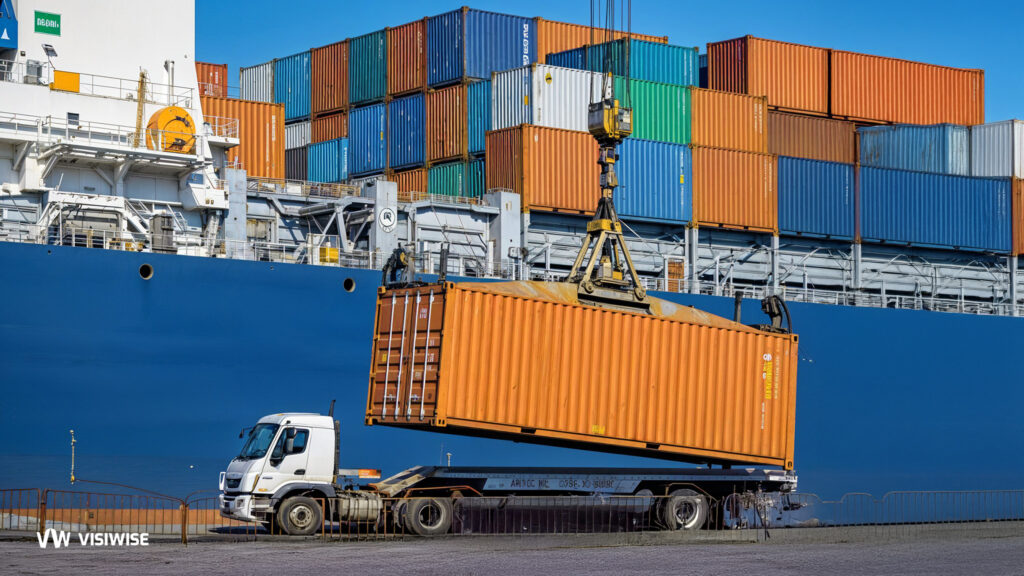In the dynamic landscape of logistics, where efficiency, precision, and timely delivery are paramount, the integration of data analytics has emerged as a transformative force. Logistics analytics, encompassing big data analytics, predictive analytics, and real-time insights, has become indispensable for organizations seeking to optimize their operations, enhance customer satisfaction, and stay ahead in a competitive market. This article delves into the multifaceted realm of logistics analytics, exploring its significance, applications, and the pivotal role it plays in revolutionizing the transportation and supply chain sectors.
In this article, we’ll discuss the role of data analytics in logistics, delve into the concept of big data, and explore its impact on supply chain management
The Significance of Logistics Analytics
Logistics analytics, characterized by the systematic analysis of data related to transportation, warehousing, inventory management, and supply chain operations, holds immense significance in today’s interconnected world. By harnessing the power of data, organizations can gain valuable insights into their operations, identify inefficiencies, and make informed decisions to streamline processes and enhance overall performance. Whether it’s optimizing route planning, minimizing transportation costs, or ensuring the timely delivery of goods, logistics analytics serves as a strategic tool for driving operational excellence and achieving competitive advantage.
Big Data Analytics in Logistics
What is big data?
Big Data encompasses datasets that surpass the capabilities of traditional databases, typically characterized by large volumes, high velocity, or diverse data types. Its complexity is heightened by advancements in artificial intelligence, social media, and the Internet of Things. However, akin to raw diamonds, data lacks value without systematic processing – it must undergo big data analytics, merging raw information with expertise to yield actionable insights.
Large-scale data analysis unveils historical patterns, detects real-time changes, and generates future forecasts. Data can be structured, comprising specific figures from conventional systems, readily accessible for immediate use. Conversely, unstructured data is sourced from various sources like vehicle motion data, traffic information, and social media posts. This data requires cleaning and preparation before interpretation.
Big Data Logistics: Use Cases
The overarching goal of big data analytics is to safeguard operational standards and increase efficiency. Transparent operational data and its specific analysis reduce costs, maintain value, improve services, and avoid waste and risks.
Stock and Storage Control
Recording and monitoring all inventory data implies knowing where to find required supplies in the warehouse at any given time. Analyzing inventory data from systems and from sensors helps determine if stocks are running low or if pallet racks are empty. Inventory forecasts can be made to predict the expected pattern of incoming orders and deliveries during the upcoming peak and off-peak seasons.
Route Optimization
This is not just about the shortest route from point A to point B. Vehicle information, product data, GPS data, weather data, and even shift schedules all go into calculating the best possible route for a particular vehicle with its specific load. In big data analytics, all the various factors are considered and evaluated to determine the route to choose.
The best route is not necessarily the fastest. Security issues are also important. In case of goods that are sensitive to shock, for example, routes are chosen that avoid cobblestones, while shock sensors monitor the safety of the goods being transported. In addition, data on fuel consumption and driving behavior, as well as environmental data measured via vehicle sensors, can calculate the eco-balance of deliveries and enhance the routing in terms of environmental impact as well.
Capacity Planning
Vehicles, storage space, or personnel are important factors for the achievable handling capacity. With the help of big data analytics, the utilization and availability of these various capacity factors are compared for each individual logistics process step in different demand situations. This facilitates capacity forecasts. Machine and vehicle capacities are matched with staff capacities or available vehicles with demand peaks. Overcapacity is expensive and undercapacity reduces service performance and consequently customer satisfaction. If all capacities are perfectly matched via big data, overcapacities and undercapacities can be avoided.
Risk Management
Risk management also benefits from improved forecasting. Recurring events in specific processes are analyzed, making patterns and the probability of these events more transparent. Factors that have repeatedly led to disruptions in the supply chain are identified and measures to eliminate them become possible.
Customer Satisfaction
Accurate knowledge of customer preferences strengthens customer loyalty. There is a huge amount of unstructured data on customer-specific likes and dislikes from all kinds of information channels. With big data analytics, they can be systematically processed to optimize customer service. When big data provides a comprehensive overview of customer needs, service quality and customer satisfaction can be increased.
How Big Data Will Shape the Future of Logistics
The logistics sector is inherently data-driven, making the widespread adoption of big data a natural progression. Many industry stakeholders recognize that leveraging big data effectively will define the future of supply chain management, offering opportunities to enhance quality and performance across the logistics industry. The challenge lies in harnessing the full potential of data and transforming it into actionable insights. With the increasing integration of technologies like the Internet of Things, artificial intelligence, cloud computing, and blockchain, the importance of data analytics continues to grow. While big data already facilitates tasks such as route and maintenance planning, its predictive capabilities will become increasingly central in the future. This could entail forecasts of departure times and delivery dates throughout the entire supply chain, as well as predictions regarding demand and transportation volumes.
Predictive Analytics in Logistics
Predictive analytics, a subset of big data analytics, plays a crucial role in enhancing the predictive capabilities of logistics operations. By analyzing historical data, identifying patterns, and applying statistical algorithms, predictive analytics enables organizations to anticipate future events and make data-driven decisions. In the context of logistics, predictive analytics can be applied to various aspects of operations, including demand forecasting, inventory optimization, and risk management.
For instance, predictive analytics models can analyze historical sales data, market trends, and external factors such as weather patterns and economic indicators to forecast future demand with greater accuracy. By accurately predicting demand fluctuations, organizations can optimize inventory levels, reduce stockouts, and minimize excess inventory carrying costs. Moreover, predictive analytics can help identify potential bottlenecks in the supply chain, anticipate equipment failures, and optimize maintenance schedules, thereby improving asset utilization and reducing downtime.
Real-Time Logistics Analytics
In today’s fast-paced business environment, the ability to access real-time insights is critical for effective decision-making and responsive operations. Real-time logistics analytics leverages technologies such as IoT sensors, GPS tracking, and cloud computing to capture, process, and analyze data in real-time, enabling organizations to monitor and manage their operations with unprecedented speed and precision.
By integrating real-time data streams from various sources, such as vehicles, warehouses, and distribution centers, organizations can gain a comprehensive view of their logistics operations and respond rapidly to changing conditions. For example, real-time analytics can alert organizations to potential delivery delays, route deviations, or inventory shortages, allowing them to take proactive measures to mitigate risks and maintain service levels. Furthermore, by analyzing real-time data on traffic conditions, weather patterns, and road closures, organizations can optimize route planning, improve delivery ETAs, and enhance overall transportation efficiency.
Data Analytics in Transportation
Transportation plays a central role in the logistics ecosystem, serving as the backbone of supply chain operations. Data analytics in transportation encompasses a wide range of applications, including route optimization, vehicle tracking, fuel management, and driver performance monitoring. By leveraging data analytics techniques such as geospatial analysis, route optimization algorithms, and predictive modeling, organizations can optimize transportation operations and reduce costs while improving service levels.
For instance, route optimization algorithms can analyze factors such as distance, traffic patterns, and delivery windows to determine the most efficient routes for transportation vehicles. By minimizing travel distances and reducing idle time, organizations can lower fuel consumption, reduce emissions, and improve overall fleet efficiency. Moreover, by tracking vehicle performance metrics such as fuel efficiency, speed, and maintenance history, organizations can identify opportunities for optimization, optimize maintenance schedules, and extend the lifespan of their vehicles.
Supply Chain Analytics
What is supply chain analytics?
Supply chain analytics is a discipline that employs data analytics methodologies and tools to enhance the management, operations, and efficiency of supply chains. In today’s interconnected and complex business environment, supply chains generate vast amounts of data, often referred to as big data. Supply chain analysts leverage analytics techniques to extract meaningful insights from this data, enabling them to understand trends, identify inefficiencies, and develop actionable solutions. By making data-driven decisions, supply chain analytics facilitates the development, maintenance, and optimization of global distribution networks, ultimately improving overall supply chain performance and responsiveness to market dynamics.
Benefits
There are many benefits to using supply chain analytics. Some of the most common include:
- More efficient supply chain management
- Reduced operational costs
- Improved planning
- Better risk management
- Greater understanding of future events
Types of analytics
Supply chain analytics encompasses five primary types, each serving distinct functions:
- Descriptive Analytics: Descriptive analytics utilizes data to depict trends and relationships within the supply chain, such as performance metrics or inventory levels in warehouses. Logistics professionals employ descriptive analytics to gain insights into the current functioning of the supply chain and its components.
- Diagnostic Analytics: Diagnostic analytics leverages data to diagnose supply chain issues, such as delays in shipments or failure to meet sales targets. By analyzing data, logistics professionals uncover the root causes behind observed trends or relationships, enhancing their understanding of contributing factors.
- Predictive Analytics: Predictive analytics utilizes data to forecast future outcomes, such as predicting demand or anticipating maintenance requirements. Logistics professionals employ predictive analytics to develop statistical models that enable proactive preparation for potential future events, whether routine demand fluctuations or unforeseen global disruptions.
- Prescriptive Analytics: Prescriptive analytics harnesses data to recommend courses of action, such as optimizing inventory management or enhancing operational efficiency. By integrating insights from descriptive and predictive analytics, logistics professionals design tailored solutions to address identified challenges and optimize performance.
- Cognitive Analytics: Cognitive analytics employs advanced techniques like artificial intelligence and machine learning to analyze large datasets rapidly and generate accurate insights. Logistics professionals leverage cognitive analytics to effectively manage and interpret the vast amounts of data generated by supply chains on a daily basis.
The Symbiotic Relationship Between Data Analytics in Logistics and the Supply Chain
Analyzing data in logistics uncovers hidden inefficiencies and bottlenecks within the supply chain. By examining data from ERP systems, TMS, WMS, and external factors like market trends, organizations gain insights into operational shortcomings. This analysis may reveal suboptimal transportation routes, excessive inventory levels in certain warehouses, or inefficient processes. Identifying these inefficiencies empowers supply chain managers to implement corrective measures, streamline operations, and reduce costs.
Forecasting Accuracy: Optimizing Demand and Inventory
Data analytics plays a pivotal role in demand forecasting and inventory optimization within the supply chain. By analyzing historical sales data, market trends, and other relevant factors, organizations accurately predict future demand for their products. This enables them to maintain optimal inventory levels, minimize stockouts, and reduce excess inventory carrying costs. The precision of demand forecasting facilitated by data analytics ensures that organizations can meet customer demand efficiently while avoiding overstocking or understocking scenarios.
Streamlining Transportation: Route Optimization and Real-Time Monitoring
Transportation management significantly improves through data analytics, particularly in route optimization and real-time monitoring. Leveraging data analytics tools enables organizations to optimize route planning, reduce transit times, and improve fleet utilization. Real-time monitoring allows companies to track vehicles, monitor shipments, and promptly address any disruptions or delays. This ensures timely delivery of goods to customers, enhances customer satisfaction, and improves overall operational efficiency in the transportation segment of the supply chain.
The Power of Data Analytics Integration with Visiwise
Integration of data analytics into a visibility platform like Visiwise streamlines and enhances the logistics process by providing smoother, more precise, and real-time insights. Visiwise facilitates the integration of data from various sources, including ERP, TMS, WMS, and spreadsheets, into a centralized platform. This integration eliminates silos and enables organizations to leverage a comprehensive dataset for analysis. Furthermore, Visiwise can be customized based on the unique workflow and business operations of each organization, ensuring that the analytics tools align with specific needs and objectives. The result is improved supply chain management, with enhanced visibility, predictive capabilities, and decision-making accuracy. By harnessing the power of data analytics within Visiwise, organizations can optimize operations, reduce costs, and drive efficiency across the entire supply chain.
Final Thoughts
In conclusion, data analytics holds immense promise for transforming the logistics industry. By leveraging advanced analytics techniques and harnessing the power of big data, organizations can optimize operations, enhance efficiency, and improve customer satisfaction. From route optimization and inventory management to predictive maintenance and risk mitigation, data analytics offers a wealth of opportunities for innovation and improvement. As logistics continues to evolve in an increasingly digital world, organizations that embrace data analytics will be better positioned to navigate challenges, capitalize on opportunities, and drive success in the dynamic landscape of logistics.



